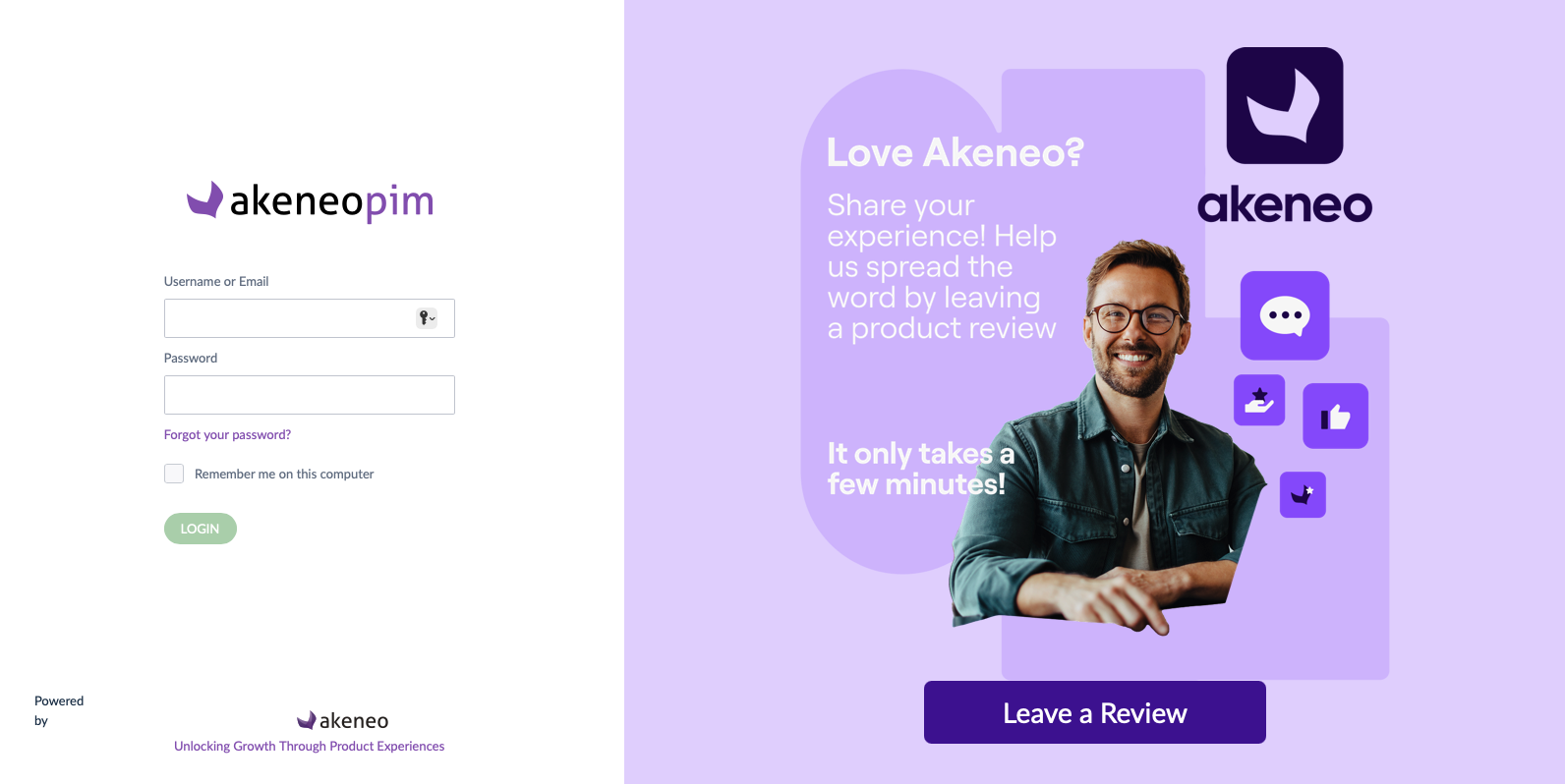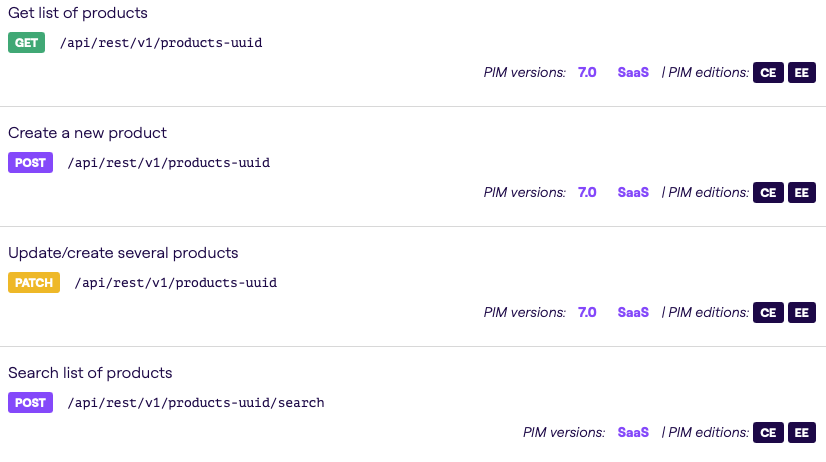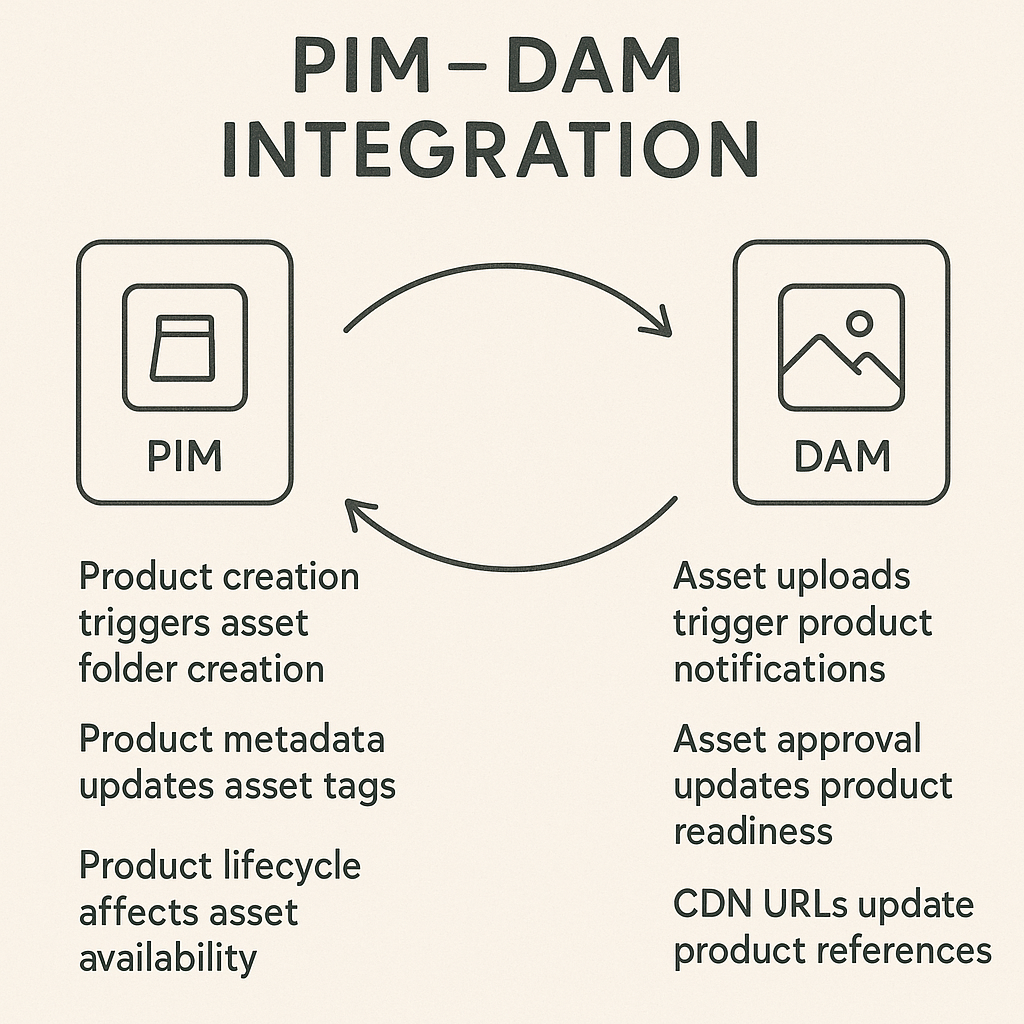Platform Overview
Akeneo is a French-founded PIM platform that offers both open-source and enterprise solutions. Founded in 2013 and headquartered in Nantes, France, Akeneo has built a strong developer community around its GPL-v3 licensed Community Edition.
The platform centers its data model around Products and their hierarchy while remaining flexible through Families (templates of attribute sets) and Variants. This approach provides a good balance between structure and flexibility for most product catalogs.
Key Facts
- Founded: 2013
- Headquarters: Nantes, France
- Employees: 200+
- License: GPL-v3 (Community Edition)
- API: REST-based with OAuth2 authentication

Akeneo Login Interface
The Akeneo login interface showcases the clean, modern design that extends throughout the platform.
Core entities in Akeneo's data model with their relationships and key attributes
| Entity | Vendor Name | Description | Key Attributes | Relationships |
|---|---|---|---|---|
Product | Product | Sellable SKU; can be simple (no variants) or variant (child of a product-model) | identifier family categories values | belongs to Family categorized in Categories child of Product Model |
Product Model | Product Model | Represents a style/parent in the variant tree; can be two-level (model > sub-model > product) | code family_variant categories values | has Family Variant parent of Products |
Family | Family | Template that groups mandatory and optional attributes for a product | code attributes attribute_requirements | contains Attributes used by Products |
Attribute | Attribute | Defines a single piece of data (text, number, boolean, media file, reference data, etc.) | code type localizable scopable | grouped in Attribute Groups used in Families |
Category | Category | Classifies products in hierarchies used by channels | code parent labels | hierarchical structure used by Channels |
Channel | Channel | A combination of locale(s), currency(ies) and category tree representing a commerce destination | code locales currencies category_tree | uses Category tree defines scope for attributes |
New to PIM systems?
Before diving into Akeneo specifics, you might want to read our detailed guide to PIM systems to understand the fundamentals and key concepts.
Read PIM Systems GuidePlatform Demo & Interface
Watch this comprehensive demo showcasing Akeneo PIM covering the basic user activities: finding products, enriching products, merchandising products, and publishing products. Recorded on Akeneo CE 6.0 in May 2022.
Strategic considerations for Akeneo implementation including data architecture, integration patterns, and platform decisions
"I find the UI of Akeneo very user-friendly. The interface centers around the product list, making it easy to understand the inheritance to variants with this view. The product list and inheritance work seamlessly together, and if you can align this with your data model, it performs remarkably well."
API Implementation Details
Authentication & Security
Akeneo uses OAuth2 authentication with both password grant and client credentials flows. Access tokens expire after 3600 seconds (1 hour), requiring refresh for long-running integrations. The API supports both username/password authentication for user-specific access and client credentials for system-to-system integration.
PHP-Centric Integration Ecosystem
Akeneo's integration patterns are heavily oriented toward PHP development environments. While comprehensive REST endpoints are available, the platform's tooling, examples, and official SDK primarily target PHP-based implementations. This can present challenges for teams working in other technology stacks, as generating robust API clients may require additional development effort compared to platforms with extensive Swagger/OpenAPI specifications.
Search & Filtering
Search capabilities are implemented through JSON-based filter criteria sent in request bodies. The system supports advanced operators per data type (=, !=, IN, NOT IN, LIKE, STARTS WITH, <, <=, >, >=, BETWEEN, EMPTY, NOT EMPTY) and uses search-after pagination for efficient handling of large result sets. All searches can be scoped by channel and locale.
Rate Limiting & Performance
SaaS deployments enforce rate limiting with X-Rate-Limit-Limit and X-Rate-Limit-Remaining headers for monitoring. To avoid hitting rate limits, implement a caching middle layer and avoid hammering the API with rapid successive requests. Self-hosted installations have no built-in rate limiting. Bulk operations support multiple items per PATCH request, with asynchronous job APIs available for larger imports and exports.
Webhooks & Event Platform
Akeneo provides webhook functionality through its Event Platform (typically bundled with Enterprise Edition), which enables real-time event streaming for product changes and other system events. However, webhook configuration has no UI and must be done programmatically via API tools like Postman, as detailed in the Event Platform documentation. This approach differs from platforms offering native UI-based webhook management, requiring technical expertise to set up and maintain webhook subscriptions.
Documentation Quality
The API documentation at api.akeneo.com is comprehensive and developer-friendly, featuring interactive examples, code samples in multiple programming languages, detailed endpoint descriptions, and clear error response documentation. An official PHP SDK is maintained, with community SDKs available for other languages.

Akeneo API Documentation
Akeneo's API documentation is comprehensive and well-organized, providing clear examples and endpoint descriptions with interactive testing capabilities.
API Usage Example
Example showing how to search for and update a product using the Akeneo REST API
# Find a product by SKU and update attribute using Akeneo API
TOKEN="<client_token>"
BASE="https://demo.akeneo.com/api/rest/v1"
# search product
curl -s -H "Authorization: Bearer $TOKEN" "$BASE/products?search={\"identifier\":[{\"operator\":\"=\",\"value\":\"SKU-12345\"}]}" > product.json
# update name
PRODUCT_CODE=$(jq -r '._embedded.items[0].identifier' product.json)
cat > patch.json <<EOF
{"name": {"en_US": "New product name 2025"}}
EOF
curl -X PATCH -H "Authorization: Bearer $TOKEN" -H "Content-Type: application/json" \
-d @patch.json "$BASE/products/$PRODUCT_CODE""Having migrated to and from Akeneo several times, I find the API intuitive, though product structures and attribute IDs can be complex. I typically save field mappings as descriptions of attribute types since no concept of attribute settings exists in the standard interface."
Technical Specifications
Custom Entity Support
Akeneo supports custom entities through Reference Entities (Enterprise Edition), but these are second-class citizens with limited capabilities compared to Products. Reference Entities lack workflow, completeness scoring, and advanced validation features available to Products.
Search Capabilities
The REST API supports comprehensive search with operators including =, !=, IN, NOT IN, LIKE, NOT LIKE, STARTS WITH, <, <=, >, >=, BETWEEN, EMPTY, and NOT EMPTY. Search after pagination is supported for large result sets.
Bulk Operations
PATCH list endpoints allow upsert of up to 100 resources per call. Asynchronous exports/imports are triggered via /api/rest/v1/jobs endpoints for larger operations.
Data Storage
Akeneo stores attribute values as JSON blobs keyed by attribute code, scope (channel), and locale. Indexing is handled automatically behind the scenes, with the main consideration being which attributes should be configured as identifier types.
Want to get your own instance of Akeneo Community Edition up and running? Follow our detailed, step-by-step installation guide using Docker.
Limitations & Implementation Considerations
Community Edition Constraints
The Community Edition lacks critical enterprise features including read-only fields, Event Platform access, and advanced workflow capabilities. Image configuration can be challenging and often requires a separate MySQL instance, making it suitable only for businesses with significant technical resources.
Webhook Configuration Complexity
While Akeneo offers webhooks through its Event Platform (Enterprise Edition), configuration requires API-based setup via tools like Postman with no UI support. This technical barrier makes webhook management more complex than platforms offering UI-based webhook configuration.
Reference Entities as Second-Class Citizens
Reference Entities (Enterprise Edition) have limited capabilities compared to Products, lacking workflow, completeness scoring, and advanced validation features. This creates inconsistencies in data management approaches across entity types.
Asset Management Limitations
Built-in asset management is basic compared to dedicated DAM solutions. Organizations with extensive digital asset requirements typically need external DAM integration, adding complexity and cost to the overall solution.
Article List Modeling Challenges
For companies working with article lists, Akeneo's Family-based model presents challenges since attributes are determined by Family hierarchy. When article lists span multiple families, they don't map directly to flat structures like Excel tables.
API Rate Limiting
SaaS deployments enforce rate limiting that can impact high-volume integrations. Self-hosted installations require careful performance tuning and infrastructure management to handle large catalogs effectively.
Deployment Complexity
Self-hosted installations require PHP expertise and ongoing maintenance. For commercial considerations and deployment strategies, refer to our comprehensive SaaS negotiation guide.
Key Benefits & Strengths
Strong Inheritance Model with Simple UI
Akeneo's Family and Family Variant system provides powerful inheritance capabilities while maintaining an intuitive user interface. Product Models can inherit attributes down to variant products, reducing data entry and ensuring consistency across product lines.
Open Source Foundation with Limitations
The GPL-v3 licensed Community Edition provides core PIM functionality without licensing costs, including the complete data model, REST API, and basic features. However, the Community Edition lacks advanced features such as read-only attributes and events, making it accessible for businesses with technical resources but with some functional constraints.
Flexible Data Architecture
The attribute-based data model with Families allows for highly flexible product structures. Products can have different attribute sets while maintaining consistency within product families, supporting diverse catalog requirements.
Article List Modeling Challenges
For companies working with article lists, Akeneo's model can present challenges since attributes on an article are determined by the Family hierarchy. When a list of articles for a quote spans several families, it doesn't map directly to flat structures like Excel tables, requiring careful data modeling consideration.
Developer-Friendly API
The REST API is comprehensive and well-documented, with support for complex search operations, bulk updates, and detailed error handling. The API-first approach enables seamless integrations with external systems.
Localization & Channel Support
Built-in support for multiple locales and channels allows global businesses to manage product information across different markets and sales channels from a single platform.
Active Community & Documentation
Strong developer community with extensive documentation, GitHub repository with active development, and comprehensive API reference materials support implementation and customization efforts.
Sivert Kjøller Bertelsen
PIM Implementation Consultant • Multiple Akeneo implementations
"Akeneo strikes an excellent balance between functionality and usability. The product-centric UI design makes it intuitive for business users, while the robust API supports complex integration scenarios. The open-source foundation provides tremendous value, though enterprise features are requied for read-only fields and web hooks. For organizations with technical resources, Akeneo offers a compelling PIM solution."


